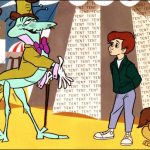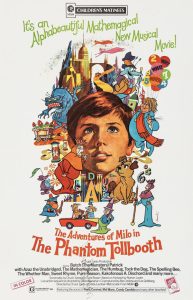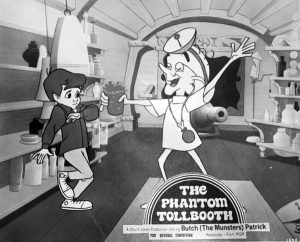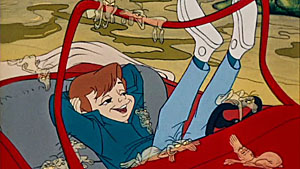



The Phantom Tollbooth (1970)
Directed by Chuck Jones, Abe Leviton and Dave Monahan (live action)
Shown from left: Spelling Bee (voice of Cliff Norton), Humbug (voice of Les Tremayne), Milo (voice of Butch Patrick), Tock, the watchdog (voice of Shep Menken)
“Everything’s a big waste of time. When I’m in school, all I want to do is be out. When I’m not in school, I want to be someplace else. If only something could happen sometime.” So laments Milo, the bored grade schoolboy at the beginning of The Phantom Tollbooth.
He gets that “something” to “happen sometime,” finding himself on an adventure in another world that most definitely serves as the cure for his boredom in this live action/animated movie celebrating its fifty-fifth anniversary this fall.
 Based on the 1961 book of the same name by author Norman Juster, and directed by Chuck Jones and Abe Levitow (with Dave Monahan helming the live-action segments), The Phantom Tollbooth opens with jaded Milo, played by Butch Patrick (of Little Eddie from The Munsters fame) coming home from school and complaining to his friend over the phone about how uninteresting everything is.
Based on the 1961 book of the same name by author Norman Juster, and directed by Chuck Jones and Abe Levitow (with Dave Monahan helming the live-action segments), The Phantom Tollbooth opens with jaded Milo, played by Butch Patrick (of Little Eddie from The Munsters fame) coming home from school and complaining to his friend over the phone about how uninteresting everything is.
Suddenly, a tollbooth appears in his house, along with a small sports car, and Milo finds himself driving off to the Wonderland-like Lands Beyond. Here, he finds areas all differently themed, such as the Doldroms, which are all about boredom, the Mountains of Ignorance, Dictionopolis (all about words), and Digitopolis (all about mathematics). They are all watched over by the Castle in the Air and are at odds. Milo finds he must save these lands by rescuing the Princesses of Rhyme and Reason.
On his adventure, Milo meets an eclectic array of denizens of this land, such as Officer Short Shrift, the Whether Man, Tock the dog, Dr. Kakofonous A. Dischord, and Faintly Macabre the Not-So-Wicked-Witch.
The Phantom Tollbooth first surfaced as a film project in 1966 at MGM. Jones had come to the studio in 1962, when he founded his Sib Tower 12 Productions (which he started with his business partner, Les Goldman), creating new Tom and Jerry cartoons for MGM, after Warner Bros. closed its animation studio.
 In a 1971 interview with Michael Barrier and Bill Spicer for Funnyworld, Jones recalled this period by saying, “Theaters were closing, and television was coming up, and Hanna-Barbera was doing all Saturday morning programs. Friz [Freleng] and I had put together the Bugs Bunny television show for Warner Bros. We had produced, written, and directed the thing together, the only time we really worked together. This method didn’t work out well, either, even though the product was good. It wasn’t my fault or his fault; it’s just that we had always been independent. It was obvious, with rising costs, that Warner’s wasn’t going to spend more than they’ve been spending on shorts, and they wanted to spend less. They finally decided not to do any.”
In a 1971 interview with Michael Barrier and Bill Spicer for Funnyworld, Jones recalled this period by saying, “Theaters were closing, and television was coming up, and Hanna-Barbera was doing all Saturday morning programs. Friz [Freleng] and I had put together the Bugs Bunny television show for Warner Bros. We had produced, written, and directed the thing together, the only time we really worked together. This method didn’t work out well, either, even though the product was good. It wasn’t my fault or his fault; it’s just that we had always been independent. It was obvious, with rising costs, that Warner’s wasn’t going to spend more than they’ve been spending on shorts, and they wanted to spend less. They finally decided not to do any.”
While at MGM, in addition to the Tom and Jerry shorts, Jones also produced and co-directed the Academy Award-winning short The Dot and Line, and the classic holiday TV special, How the Grinch Stole Christmas. With The Phantom Tollbooth, the feature had been completed in 1968, but its release was held up due to issues at MGM, and it wasn’t released until November 7, 1970.
Aside from the compilation film, The Bugs Bunny/Road Runner Movie (1979), The Phantom Tollbooth serves as Jones only feature film directing credit. With his regular collaborator Levitow, as co-director, the film bears both of their unmistakable styles.
With backgrounds by Philip DeGuard, the design of the Lands Beyond that Milo enters is a psychedelic, off-kilter setting with the Castle in the Air hanging ominously in the distance, highlighted by flashes of lightning.
 Throughout the adventure, the film features songs by the songwriting teams of Lee Pockriss and Norman Gimbel, and Norman Martin and Paul Vance.
Throughout the adventure, the film features songs by the songwriting teams of Lee Pockriss and Norman Gimbel, and Norman Martin and Paul Vance.
The Phantom Tollbooth also boasts a “who’s who” of legendary voice actors and animators. Mel Blanc, Daws Butler, June Foray, Hans Conried, Les Tremayne, Shepard Menken, Thurl Ravenscroft, Candy Candido, Patti Gilbert, Cliff Norton, and Larry Thor are among the notables whose familiar voices can be heard in the cast.
With this, such animation luminaries as Hal Ambro, Corny Cole, Bill Littlejohn, Phil Roman, and Irv Spence are among the many who brought the eccentric characters to life. Of note are the Lethargians, gelatinous masses who try to pull Milo into their lazy morass in a sequence that’s both humorous and ominous. And the character, the “Awful DYNN,” loud noise personified, is a wildly-designed creature who looks like finger paints come to life.
When The Phantom Tollbooth was released, it was well received by critics. Reviewing the film for Cinefantastique, Dale Winogura wrote, “While there is little of the light, endearing sentimentality and stylish charm of, say, Disney’s Sleeping Beauty and Bambi, The Phantom Tollbooth sees a sophistication in children’s story, characterization and development unusual in a cartoon feature and a delightful change of pace as well.”
And as Andrew Leal noted in Jerry Beck’s book, The Animated Movie Guide, it’s “Definitely recommended for any Chuck Jones fans.” In the fifty-five years since its release, The Phantom Tollbooth has, unfortunately, fallen through the cracks. But, with its anniversary this fall, it’s worth a revisit for its messages of using time wisely and seeking out knowledge. Or, as Tock the Dog notes in one of the film’s songs, “Time is a gift, given to you, given to give you the time you need, the time you need to have the time of your life.”